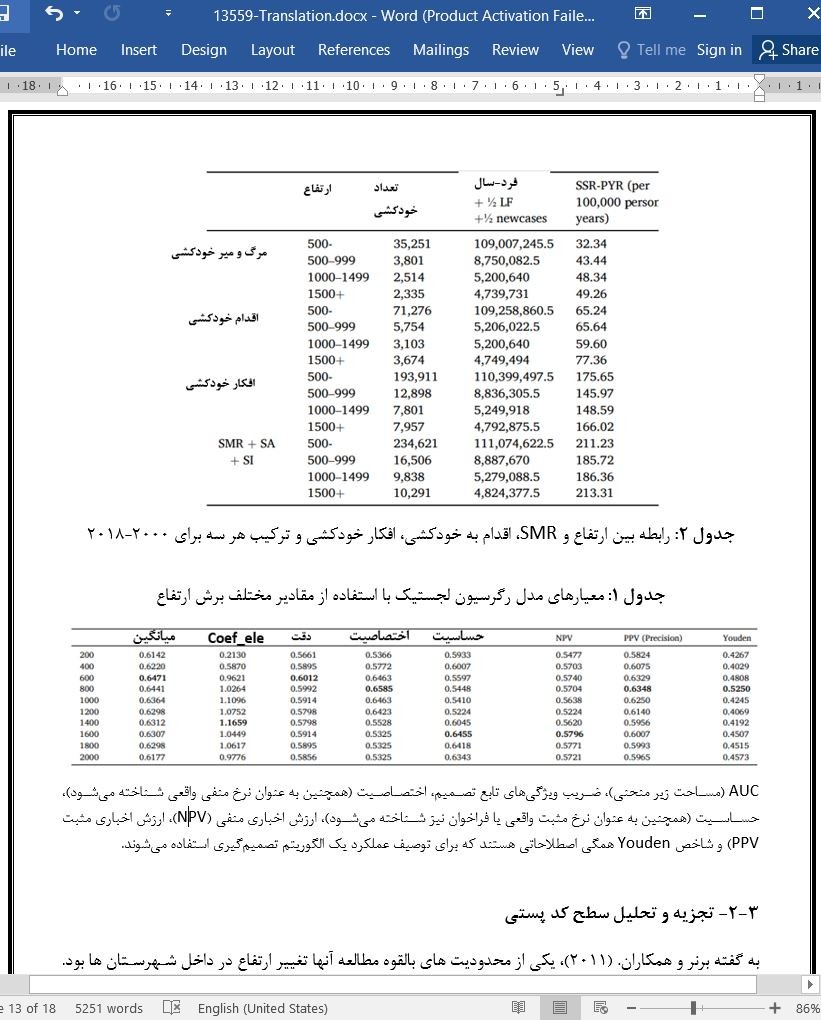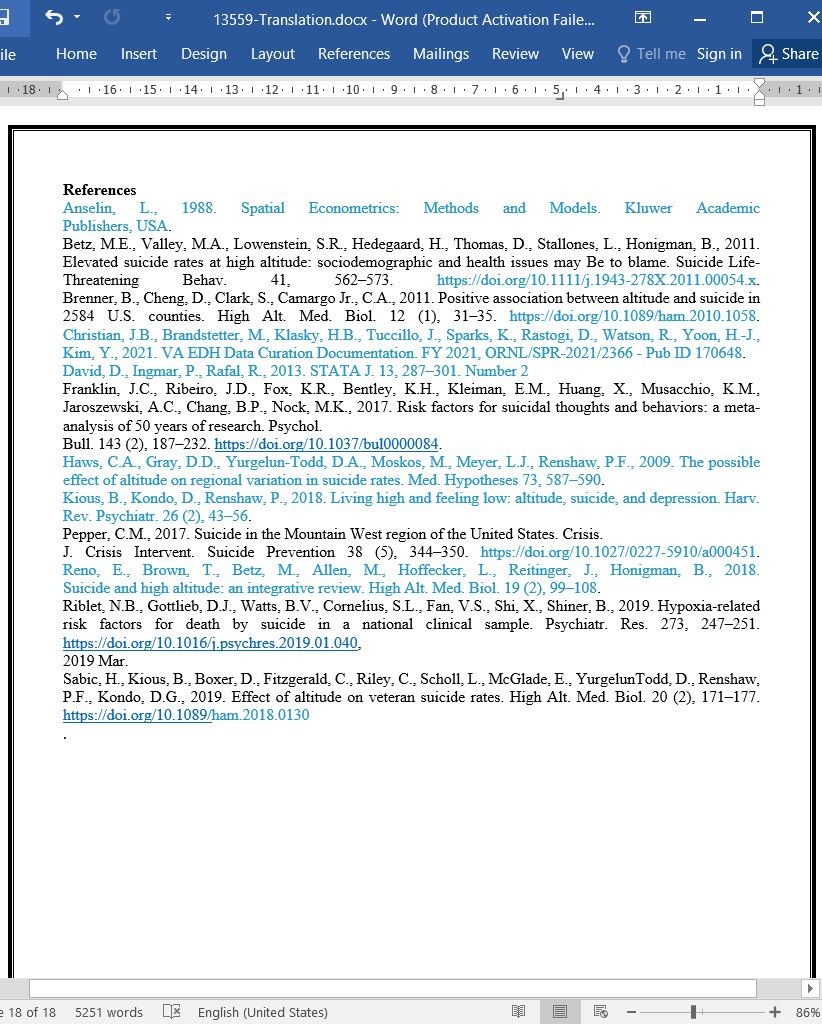
دانلود مقاله تحلیل رابطه بین ارتفاع و مرگ های خودکشی کهنه سربازان، اقدام به خودکشی و افکار خودکشی
خلاصه
کهنه سربازان ایالات متحده و به طور کلی آمریکایی ها تحت تأثیر خودکشی قرار دارند که یک مسئله جدی بهداشت عمومی است. عوامل متعددی، از جمله ارتفاع، جمعیت شناختی، بالینی، بیولوژیکی و جغرافیایی با خطر خودکشی و رفتار خودکشی مرتبط هستند. با این حال، ماهیت دقیق ارتباط بین ارتفاع و خودکشی هنوز ناشناخته است تا حدی به این دلیل که تحقیقات قبلی فقط از دادههای سطح فردی یا دادههای مکانی استفاده کردهاند، نه از هر دو. طیف کامل افکار و اعمال خودکشی، از افکار خودکشی گرفته تا مرگ و میر خودکشی، در مطالعات قبلی مورد توجه قرار نگرفته است. بر این اساس، هدف مطالعه حاضر ارزیابی کامل رابطه بین ارتفاع و مرگ و میر خودکشی، اقدام به خودکشی و افکار خودکشی در میان کهنهسربازان ایالات متحده بین سالهای 2000 تا 2018 با استفاده از دادههای جغرافیایی (کد پستی و شهرستانی) و دادههای سطح فردی بود. یافتههای ما نشان میدهد که با استفاده از انواع تحلیلهای آماری و حتی پس از تعدیل متغیرهای کمکی معنیدار مانند درآمد متوسط خانوار، سن بالای ۵۰ سال، جنسیت مرد، غیر سفیدپوست، نژاد اسپانیایی تبار و تراکم جمعیت، رابطه معناداری بین ارتفاع و میزان خودکشی در تمام سطوح تحقیق وجود دارد. ما نشان میدهیم که ارتفاع و اقدام به خودکشی همبستگی مثبت دارند، بهویژه زمانی که متغیرهای کمکی را کنترل میکنیم و اینکه ارتفاع و افکار خودکشی و همچنین ترکیبی از خودکشی، اقدام به خودکشی و افکار خودکشی، فقط به طور جزئی همبستگی دارند.
1- مقدمه
دفتر سلامت روان و پیشگیری از خودکشی (OMHSP) وزارت امور کهنهسربازان (VA) اخیراً تخمینهایی را منتشر کرده است که نشان میدهد میزان مرگ و میر خودکشی (SMR) در میان جانبازان 51 درصد بیشتر از نرخ در میان غیرنظامیان پس از تنظیم سن و جنس است. خطر و رفتار خودکشی با عوامل مختلفی مرتبط است (فرانکلین و همکاران، 2017). جغرافیا یکی از این عوامل خطر است، به طوری که منطقه کوهستانی غرب ایالات متحده دارای SMR قابل توجهی بالاتر از بقیه کشور است. روستایی بودن، مالکیت اسلحه، نژاد، قومیت، دسترسی به مراقبت های بهداشتی، تنهایی، سوء مصرف مواد و خشونت خانگی تنها تعدادی از متغیرهایی هستند که برای توضیح این تفاوت پیشنهاد شده اند (بتز و همکاران، 2011؛ رنو و همکاران، 2018). ). با این حال، با توجه به اینکه افزایش SMR مشاهده شده در کوهستان غرب در بسیاری از تفاوت های جمعیتی سازگار است (پپر، 2017)، بعید به نظر می رسد که این متغیرها به تنهایی بتوانند اثرات قوی مشاهده شده را توضیح دهند. در نتیجه، علاقه به تحقیق در مورد ارتباط بین ارتفاع بالا و خطر خودکشی افزایش یافته است.
4. بحث
ما سه مطالعه را برای بررسی رابطه بین ارتفاع و رویدادهای خاص خودکشی، یعنی مرگهای خودکشی، اقدام به خودکشی، افکار خودکشی و ترکیب این سه مطالعه، با استفاده از دادههای VA از سال 2000 تا 2018. کد پستی و سطوح افراد انجام دادیم. کنترل متغیرهای مخدوش کننده بالقوه به طور قابل توجهی همبستگی را در هر مورد افزایش داد. یافتههای ما نشان میدهد که حتی پس از تصحیح عوامل اجتماعی-دموگرافیک و تأثیرات فضایی، ارتباط معنیداری بین SMR و ارتفاع در سطح شهرستان وجود دارد. در مقایسه با تجزیه و تحلیل سطح کد پستی، تجزیه و تحلیل در سطح شهرستان ارتباط بیشتری را برای اقدام به خودکشی، ایدهپردازی و ترکیب نشان داد. یافتههای ما نشاندهنده ارتباط قوی بین ارتفاع و مرگومیر/تلاشهای خودکشی در سطح کد پستی و ارتباط ضعیف بین ارتفاع و ایده یا ترکیبی از رویدادهای خاص خودکشی است. دادههای سطح فردی مشابه نتایج کد پستی تعدیلنشده هستند، زیرا روند افزایشی را نشان نمیدهند، به استثنای مرگومیر خودکشی که روند افزایشی ضعیفی را نشان میدهد. مقادیر SMR در سطح فردی با مقادیر نشان داده شده در (Riblet et al. 2019) قابل مقایسه است. یافتههای ما در سطح شهرستان، کد پستی و افراد، حتی پس از محاسبه اثرات فضایی و تأثیرات سن، جنسیت، نژاد، قومیت، درآمد و تراکم جمعیت، سازگار است. به طور کلی، ما شاهد یک روند قوی برای مرگ و میر، یک روند متوسط برای تلاش ها و یک روند متوسط برای فکر خودکشی و ترکیب این سه هستیم. ما فرض میکنیم که این به دلیل عدم گزارش افکار در میان افرادی است که در مناطق مرتفع زندگی میکنند، یا به دلیل دسترسی نادر به ارائه دهندگان سلامت روان یا به دلیل بدنامی. تحقیقات بیشتری برای درک کامل این فنوتیپ ها مورد نیاز است.
Abstract
Suicide is a major public health problem affecting US Veterans and the US in general. Many variables (e.g., demographic, clinical, biological, geographic) have been associated with risk for suicide and suicidal behavior, including altitude; however, the exact nature of the relationship between altitude and suicide remains unclear in part due to the fact that previous studies have used either geospatial data or individual-level data, but not both. Prior research has also failed to consider the full range of suicidal thoughts and behaviors, ranging from suicidal ideation to suicide deaths. Accordingly, the objective of the present research was to use both geospatial data (county and zip codes) and individual-level data to comprehensively assess the association between altitude and suicide mortality, suicide attempts, and suicidal ideation among US Veterans between 2000 and 2018. Taken together, our results demonstrate that there is a strong correlation between altitude and suicide rates at all the levels investigated and using different statistical analyses and even after controlling for significant covariates such as percent of age >50yr, percent male, percent white, percent non-Hispanic, median household income, and population density. We show that there is a positive correlation between altitude and suicide attempts especially when controlling by the covariates and a weak correlation between altitude and suicide ideation and the combination of suicide, suicide attempts and suicide ideation.
1. Introduction
Recent estimates from the Department of Veterans Affairs (VA) Office of Mental Health and Suicide Prevention (OMHSP) reveal that, after adjusting for age and sex, the suicide mortality rate (SMR) among Veterans is 51% higher than the rate among civilians. Numerous variables have been associated with risk for suicide and suicidal behavior (Franklin et al., 2017). One such risk factor is geography, as the Mountain West region of the U.S. has a significantly higher SMR compared to the rest of the country. Many factors have been postulated to explain this difference, including rurality, firearm ownership, race, ethnicity, access to health care, isolation, substance abuse, and domestic violence (Betz et al., 2011; Reno et al., 2018); however, given that the increased SMR observed in the Mountain West is consistent across many demographic differences (Pepper, 2017), it seems implausible that these factors alone could account for the robust effects observed. Thus, there has been a growing interest in exploring the association between high altitude and risk for suicide.
4. Discussion
Using VA data from 2000 to 2018, we conducted three studies to investigate the correlation between altitude and suicide-specific events, namely suicide deaths, suicide attempts, suicidal ideation, and the combination of the three. The three studies analyzed data at county, ZIP codes, and individual levels. In all cases, controlling for potential confounding factors improved the correlation substantially. Our results show that there is a strong correlation between SMR and altitude at the county level even after adjusting by socio-demographic variables and spatial effects. The county-level analysis showed a higher correlation for suicide attempts, ideation, and combination than the ZIP-code level analysis. At the ZIP codes level, our results show a strong correlation between suicide mortality/suicide attempts and altitude and a weak correlation between altitude and ideation or the combination of suicidespecific events. The individual-level results are similar to the unadjusted ZIP codes results in that they do not show an increasing trend except for the suicide mortality in which a tenuous increasing trend can be observed. The individual-level results for SMR are similar to those shown in (Riblet et al., 2019) Our results are based on a large dataset and are consistent at the county, ZIP codes and individual levels and even after accounting for spatial effects and the effects of age, sex, race, ethnicity, income, and population density. Overall, we see a trend which is strongest for deaths, moderate for attempts, and modest for ideation and the combination of the three. We hypothesize that this could be the result of ideation being under-reported among people who live in high altitude places either because of infrequent access to mental health providers or for stigma. More work needs to be done to understand these phenotypes.
خلاصه
1- مقدمه
2- داده ها و روش ها
1-2- تجزیه و تحلیل سطح شهرستان و سطح کد پستی
1-2-2-مدل رگرسیون خطی
2-1-2-مدل مکانی
3-1-2- مدل رگرسیون لجستیک
2-2-تجزیه و تحلیل در سطح فردی
3. نتایج
1-3- تجزیه و تحلیل سطح شهرستان
2-3- تجزیه و تحلیل سطح کد پستی
3-3- تجزیه و تحلیل فردی
4. بحث
منابع
Abstract
1. Introduction
2. Data and methods
2.1. County level and zip-code level analyses
2.1.1. Linear regression model
2.1.2. Geospatial model
2.1.3. Logistic regression model
2.2. Individual-level analysis
3. Results
3.1. County-level analysis
3.2. Zip-code-level analysis
3.3. Individual-level analysis
4. Discussion
Authors' contributions
Ethical board disclosure
Funding
References
این محصول شامل پاورپوینت ترجمه نیز می باشد که پس از خرید قابل دانلود می باشد. پاورپوینت این مقاله حاوی 20 اسلاید و 4 فصل است. در صورت نیاز به ارائه مقاله در کنفرانس یا سمینار می توان از این فایل پاورپوینت استفاده کرد.
در این محصول، به همراه ترجمه کامل متن، یک فایل ورد ترجمه خلاصه نیز ارائه شده است. متن فارسی این مقاله در 6 صفحه (1800 کلمه) خلاصه شده و در داخل بسته قرار گرفته است.
علاوه بر ترجمه مقاله، یک فایل ورد نیز به این محصول اضافه شده است که در آن متن به صورت یک پاراگراف انگلیسی و یک پاراگراف فارسی درج شده است که باعث می شود به راحتی قادر به تشخیص ترجمه هر بخش از مقاله و مطالعه آن باشید. این فایل برای یادگیری و مطالعه همزمان متن انگلیسی و فارسی بسیار مفید می باشد.
بخش مهم دیگری از این محصول لغت نامه یا اصطلاحات تخصصی می باشد که در آن تعداد 40 عبارت و اصطلاح تخصصی استفاده شده در این مقاله در یک فایل اکسل جمع آوری شده است. در این فایل اصطلاحات انگلیسی (تک کلمه ای یا چند کلمه ای) در یک ستون و ترجمه آنها در ستون دیگر درج شده است که در صورت نیاز می توان به راحتی از این عبارات استفاده کرد.
- ترجمه فارسی مقاله با فرمت ورد (word) با قابلیت ویرایش و pdf بدون آرم سایت ای ترجمه
- پاورپوینت فارسی با فرمت pptx
- خلاصه فارسی با فرمت ورد (word)
- متن پاراگراف به پاراگراف انگلیسی و فارسی با فرمت ورد (word)
- اصطلاحات تخصصی با فرمت اکسل



